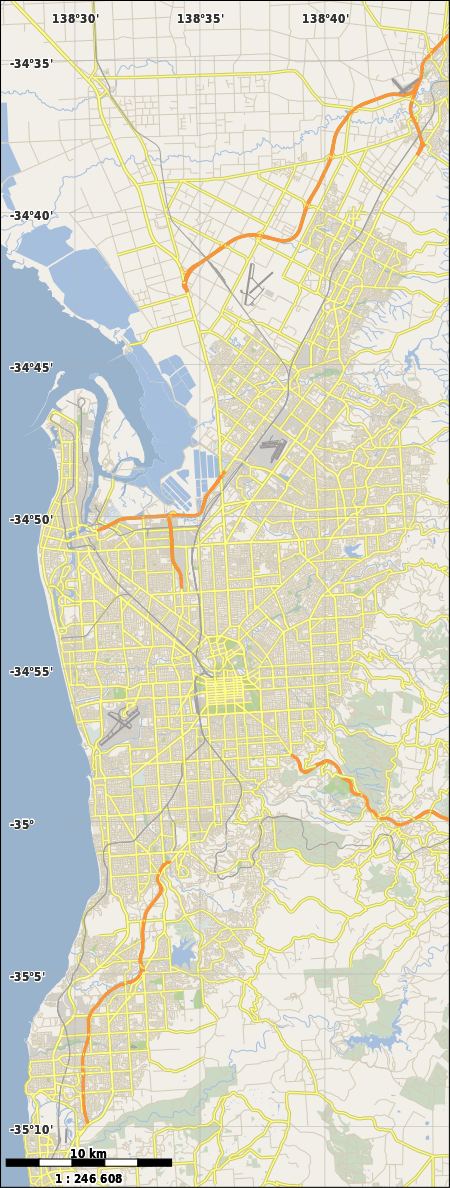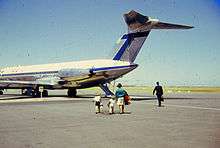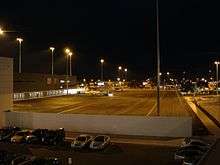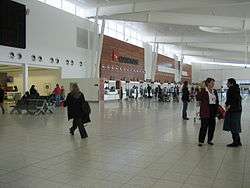Adelaide Airport
| Adelaide Airport | |||||||||||||||
|---|---|---|---|---|---|---|---|---|---|---|---|---|---|---|---|
 | |||||||||||||||
|
Adelaide Airport T1, Qantas Check in Desks | |||||||||||||||
| IATA: ADL – ICAO: YPAD | |||||||||||||||
| Summary | |||||||||||||||
| Airport type | Public | ||||||||||||||
| Operator | Adelaide Airport Limited | ||||||||||||||
| Serves | Adelaide | ||||||||||||||
| Location | Adelaide Airport, South Australia | ||||||||||||||
| Hub for |
Alliance Airlines Qantas Regional Express Airlines Sharp Airlines Cobham | ||||||||||||||
| Focus city for |
Virgin Australia Jetstar Airways | ||||||||||||||
| Elevation AMSL | 20 ft / 6 m | ||||||||||||||
| Coordinates | 34°56′42″S 138°31′50″E / 34.94500°S 138.53056°ECoordinates: 34°56′42″S 138°31′50″E / 34.94500°S 138.53056°E | ||||||||||||||
| Website | adelaideairport.com.au | ||||||||||||||
| Map | |||||||||||||||
 ADL Location in Adelaide | |||||||||||||||
| Runways | |||||||||||||||
| |||||||||||||||
| Statistics | |||||||||||||||
| |||||||||||||||
Adelaide Airport (IATA: ADL, ICAO: YPAD) is the principal airport of Adelaide, South Australia and the fifth busiest airport in Australia, servicing 7,696,000 passengers in the financial year ending 30 June 2014.[3] Located adjacent to West Beach, it is approximately 6 km (3.7 mi) west of the city-centre. It has been operated privately by Adelaide Airport Limited under a long-term lease from the Commonwealth Government since 29 May 1998.[4]:p 25
First established in 1955, a new dual international/domestic terminal was opened in 2005 which has received numerous awards, including being named the world's second-best international airport (5–15 million passengers) in 2006.[5] Also, it has been named Australia's best capital city airport in 2006, 2009 and 2011.[6]
In the financial year ended June 2014, Adelaide Airport experienced passenger growth of 25.5% internationally, growth of 3.5% domestically and a decrease of 4.7% regionally, resulting in an overall increase of 5% from the previous year.[3]
History
The first Adelaide airport was an aerodrome constructed in 1921 on 24 ha (59 acres) of land in Hendon. The small facility allowed for a mail service between Adelaide and Sydney. To meet the substantial growth in aviation, Parafield Airport was developed in 1927. The demand on aviation outgrew Parafield and the current site of Adelaide Airport was selected at West Torrens (now West Beach) in January 1946.[7] An alternative site at Port Adelaide, including a seaplane facility, was considered inferior and too far from the C.B.D.[8] Construction began and flights commenced in 1954. Parafield Airport was turned into a private and military aviation facility.

An annexe to one of the large hangars at the airport served as a passenger terminal until the Commonwealth Government provided funds for the construction of a temporary building.[9] International services became regular from 1982 upon the construction of an international terminal. A new dual-use $260 million facility replaced both the original 'temporary' domestic and international terminals in 2005.
In October 2006, the new terminal was named the Capital City Airport of the Year at the Australian Aviation Industry Awards in Cairns.[10] In March 2007, Adelaide Airport was rated the world's second best airport in the 5–15 million passengers category at the Airports Council International (ACI) 2006 awards in Dubai.[11]
Plans were announced for an expansion of the terminal in July 2007, including more aerobridges and demolition of the old International Terminal.[12]
On 5 August 2008 Tiger Airways Australia confirmed that Adelaide Airport would become the airline's second hub which would base two of the airline's Airbus A320s by early 2009.[13] On 29 October 2009 Tiger announced it would be housing its third A320 at Adelaide Airport from early 2010.[14] Tiger Airways later shut down its operations from Adelaide only to recommence them in 2013.[15]
The airport encountered major problems during the eruption of Puyehue volcano in Chile, the ash cloud caused flights to be cancelled nationwide, with over 40,000 passengers being left stranded in Adelaide.
In 2016 on the 28th of September the entire state lost power. the airport had issues with the backup generators.
Previous terminals
The original international terminal had only one gate with limited space for passengers. Check in desks were small and waiting space was limited. It was partially demolished to make the area more secure and allow aircraft to park on the other side of the terminal. The old domestic terminal was closed shortly after the new terminal was opened to flights and was demolished not long after. A new control tower was built west of the current terminal with the old control tower maintained for additional operations.
Present terminal building

The airport was redeveloped in 2005 at a cost of $260 million. The redevelopment was managed by builders Hansen Yuncken. Before the redevelopment, the old airport terminal was criticised for its limited capacity and lack of aerobridges.
Proposals were developed for an upgraded terminal of world standard. The final proposal, released in 1997, called for a large, unified terminal in which both domestic and international flights would use the same terminal. A combination of factors, the most notable of which was the collapse of Ansett Australia, then a duopoly domestic carrier with Qantas, and the resultant loss of funds for its share of the construction cost, saw the new terminal plans shelved until an agreement was reached in 2002.
The new terminal was opened on 7 October 2005 by the Prime Minister John Howard and South Australian Premier Mike Rann. However, Adelaide Airport Limited announced soon afterward that only international flights would use the new facility immediately due to problems with the fuel pumps and underground pipes. These problems related initially to the anti-rusting agent applied to the insides of the fuel pumps, then to construction debris in the pipes. Although international and regional (from December 2005) aircraft were refuelled via tankers, a lack of space and safety concerns prevented this action for domestic jet aircraft, which instead continued operations at the old terminal. The re-fueling system was cleared of all debris and the new terminal was used for all flights from 17 February 2006.[16] The new airport terminal is approximately 850 m (2,790 ft) end to end and is capable of handling 27 aircraft, including an Airbus A380, simultaneously and processing 3,000 passengers per hour. It includes high-amenity public and airline lounges, 14 glass-sided aerobridges, 42 common user check-in desks and 34 shop fronts. Free wireless Internet is also provided throughout the terminal by Internode Systems, a first for an Australian airport.[17]
The first Qantas A380, VH-OQA "Nancy Bird Walton", landed at the airport on 27 September 2008, Several thousand spectators gathered to catch a glimpse of the giant aircraft. This was a 25-minute stopover before it flew on to Melbourne. This was one of several visits the airliner made as part of a pilot training and testing program.
In July 2013, Adelaide Airport became the first Australian airport and second airport worldwide to have Google Street View technology, allowing passengers to explore the arrival and departure sections of the airport before travel.[18]
Recent development
As of 2011 a series of developments are either underway, approved or proposed for Adelaide Airport. In February 2011 a A$100 million building program was launched as part of a five-year master plan. The developments which have been made public (whether part of the building plan or not) are listed below:
- New airport road network to improve traffic flow (completed)
- New multi-storey car park – increasing parking spaces from 800 to 1,650 (completed August 2012)[19]
- New passenger terminal plaza frontage (completed March 2013)
- Walkway bridge connecting new car park and existing terminal building (completed March 2013)
- Terminal concourse extension
- Three new aerobridges
- Terminal commercial projects and passenger facilities
- Relocation of regional carrier Rex
- Relocation of old transportable charter aircraft operators' terminal
- New control tower, twice the height of the old tower, expected to cost A$16.9 million (opened early 2012)
- Addition of Emirates airlines and Qatar Airways to the list of airlines serving the airport.
- Adelaide Airport Hotel (37 m (121 ft) tall, nine levels)
Airlines and destinations
Passenger
Cargo

| Airlines | Destinations |
|---|---|
| Air New Zealand Cargo | Auckland |
| Atlas Air operated by Emirates Sky Cargo | Dubai-International |
| Atlas Air operated by Qantas Freight | Los Angeles |
| Australian air Express operated by Cobham | Melbourne, Sydney |
| MASkargo | Kuala Lumpur–International, Sydney |
| Qantas Freight | Sydney, Singapore |
| Singapore Airlines Cargo | Singapore |
| Toll Priority operated by Pel-Air and Toll Aviation | Melbourne, Perth, Sydney, Canberra |
| Toll Priority | Melbourne, Sydney |
Traffic and statistics
Domestic
| Airport | Passengers | ||||
| Year Ending 2015/16[30] |
% Change | July 2016[31] |
% Change | ||
| 1 | 2,362,700 | 215,400 | |||
| 2 | 1,869,800 | 153,700 | |||
| 3 | 813,900 | 76,200 | |||
| 4 | 616,600 | 50,400 | |||
| 5 | 222,800 | 20,200 | |||
| 6 | 182,400 | 14,000 | |||
| 7 | 169,500 | 13.2 | |||
| 8 | 120,900 | n/a | 11,700 | ||
- Notes
- ^1 Alice Springs only included from April 2015.
International
| Airport | Passengers | ||||
| Year Ending 2015/16[32] |
% Change | June 2016[33] |
% Change | ||
| 1 | 202,502 | 14,451 | |||
| 2 | 199,632 | 14,796 | |||
| 3 | 160,202 | 16,169 | |||
| 4 | 104,696 | 8,124 | |||
| 5 | 98,295 | 6,202 | |||
| 6 | 76,243 | 4,258 | |||
| 7 | 15,632 | new | 9,079 | new | |
Annual Passengers
| Year | Passenger movements |
|---|---|
| 2001–02 | 4,180,000 |
| 2002–03 | 4,358,000 |
| 2003–04 | 4,897,000 |
| 2004–05 | 5,371,000 |
| 2005–06 | 5,776,000 |
| 2006–07 | 6,192,000 |
| 2007–08 | 6,635,000 |
| 2008–09 | 6,799,000 |
| 2009–10 | 7,030,000 |
| 2010–11 | 7,297,000 |
| 2011-12 | 6,968,000 |
| 2012-13 | 7,300,000 |
| 2013-14 | 7,696,000 |
| 2014-15 | 7,670,000 |
| 2015-16 | 7,777,747 |
| 2020-21 | 9,856,000 |
| 2025-26 | 11,552,000 |
| 2030–31 | 13,537,000 |
Cargo
| Rank | Airport | Tonnes | % Change |
|---|---|---|---|
| 1 | Singapore, Singapore | 10,995.7 | |
| 2 | Hong Kong, Hong Kong | 3,413.2 | |
| 3 | Malaysia, Kuala Lumpur–International | 2,984.4 | |
| 4 | New Zealand, Auckland | 449.4 |
Ground transport
Adelaide Metro operates frequent JetBus buses connecting the airport to the Central Business District and Glenelg. Routes J1, J1X and J3 operate to the City every 15mins. Route J1 also operates to Harbour Town Shopping Centre and Routes J1 and J3 continue to Glenelg. Routes J7 and J8 operate to West Lakes and Marion.[35] The AAL's latest airport master plan proposes a light rail service. Historically airlines provided connecting buses to the Central Business District, after which a private bus service provided a service until 2013.
See also
References
- ↑ http://www.adelaideairport.com.au/corporate/wp-content/uploads/2014/11/4-June-16-Traffic-Performance-Final.pdf
- ↑ "Airport Traffic Data 1985–86 to 2014–15". BITRE. March 2016. Retrieved 15 March 2016.
- 1 2 "Adelaide Airport records double digit international growth for the third consecutive year" (pdf). Retrieved 10 October 2014.
- ↑ "Air passengermovements through capital city airports to 2025–26" (PDF). Working Paper 72. Canberra: Bureau of Infrastructure, Transport and Regional Economics. 2008. Retrieved 16 May 2012.
- ↑ "Adelaide Airport: T1" (PDF). Adelaide Airport Limited. Archived (PDF) from the original on 19 July 2008. Retrieved 1 November 2008.
- ↑ "Adelaide names Australia's best airport again" (PDF).
- ↑ "West Beach Airport Plan Approved". The Advertiser 26 January 1946 page 1.
- ↑ "Airport For Adelaide". The Advertiser 27 June 1945 page 7.
- ↑ "History: 1927–2005". Adelaide Airport Limited. Archived from the original on 3 October 2006. Retrieved 14 October 2006.
- ↑ "China Aviation News:Adelaide Airport Rated No. 1 in Australia". En.carnoc.com. 18 October 2006. Archived from the original on 8 July 2011. Retrieved 30 May 2011.
- ↑ "Adelaide Airport Wins International Praise". En.carnoc.com. 13 March 2007. Archived from the original on 8 July 2011. Retrieved 30 May 2011.
- ↑ Innes, Stuart (12 July 2007). "Adelaide Airport boost". The Advertiser. Retrieved 13 July 2007.
- ↑ "Tiger sets up second home in Adelaide". Fairfax Digital. Melbourne: The Age. 5 August 2008. Archived from the original on 15 May 2009. Retrieved 5 August 2008.
- ↑ Innes, Stuart (29 October 2009). "Tiger Airways base in Adelaide to grow by 50 per cent". The Advertiser. News Limited.
- ↑ "Tiger Airways future Aust look under wraps". The Sydney Morning Herald. 22 August 2011.
- ↑ "Passengers urged to be patient as new SA terminal opens". Australia: ABC News. 17 February 2006. Retrieved 14 October 2006.
- ↑ Denise Murray (31 October 2005). "Weaving wireless magic". CRN. Archived from the original on 10 October 2006. Retrieved 14 October 2006.
- ↑ "Google Street View Technology First for Adelaide Airport" (PDF) (Press release). Adelaide Airport Limited. 19 July 2013. Retrieved 10 April 2015.
- ↑ "Parking". Adelaide Airport Limited. Retrieved 10 April 2015.
- 1 2 "Alliance wins new Santos contract". Australian Aviation.
- 1 2 "Cobham loses Cooper Basin FIFO contract". The Advertiser.
- ↑ "Australia's Alliance Air ends QantasLink tie-up". ch-aviation.
- ↑ http://www.traveldailymedia.com/239744/china-southern-to-start-flying-to-adelaide/
- ↑ "Jetstar includes Hobart, Adelaide on Avalon flights radar". Geelong Advertiser.
- ↑ http://australianaviation.com.au/2016/05/jetstar-announces-sunshine-coast-adelaide-flights/comment-page-1/#comment-41387
- ↑ "Qantas expands 717 domestic network". Australian Aviation.
- ↑ "QATAR AIRWAYS ANNOUNCES THE LAUNCH OF ANOTHER EXCITING AUSTRALIAN DESTINATION – ADELAIDE". Qatar Airways.
- ↑ "Tigerair Australia to serve Bali from March 2016". Australian Aviation.
- ↑ "Virgin to fly Adelaide-Alice Springs from March 2015". Australian Aviation.
- ↑ "Domestic aviation activity - Annual 2015-16" (PDF). Bureau of Infrastructure, Transport and Regional Economics (BITRE). September 2016. Retrieved 30 September 2016. Refers to "Regular Public Transport (RPT) operations only"
- ↑ "Domestic aviation activity - July 2016" (PDF). Bureau of Infrastructure, Transport and Regional Economics (BITRE). July 2016. Retrieved 30 September 2016. Refers to "Regular Public Transport (RPT) operations only"
- ↑ "City pairs data—passengers, freight and mail—2009 to current". Bureau of Infrastructure, Transport and Regional Economics (BITRE). September 2016. Retrieved 30 September 2016. Refers to "Regular Public Transport (RPT) operations only"
- ↑ "International airline activity - June 2016" (PDF). Bureau of Infrastructure, Transport and Regional Economics (BITRE). July 2016. Retrieved 30 September 2016. Refers to "Regular Public Transport (RPT) operations only"
- ↑ "Australian International Airline Activity 2011" (PDF). Bureau of Infrastructure, Transport and Regional Economics (BITRE). June 2012. Retrieved 10 July 2012. Refers to "Regular Public Transport (RPT) operations only"
- ↑ "Adelaide Metro - Stop 17327". Adelaide Metro. Retrieved 1 August 2014.
External links
![]() Media related to Adelaide Airport at Wikimedia Commons
Media related to Adelaide Airport at Wikimedia Commons
- Adelaide Airport Limited
- Adelaide Airport webcam, updated every 60 seconds. The camera is looking north east from Gate 26
- Video of Qantas A380's first visit to Adelaide Airport
